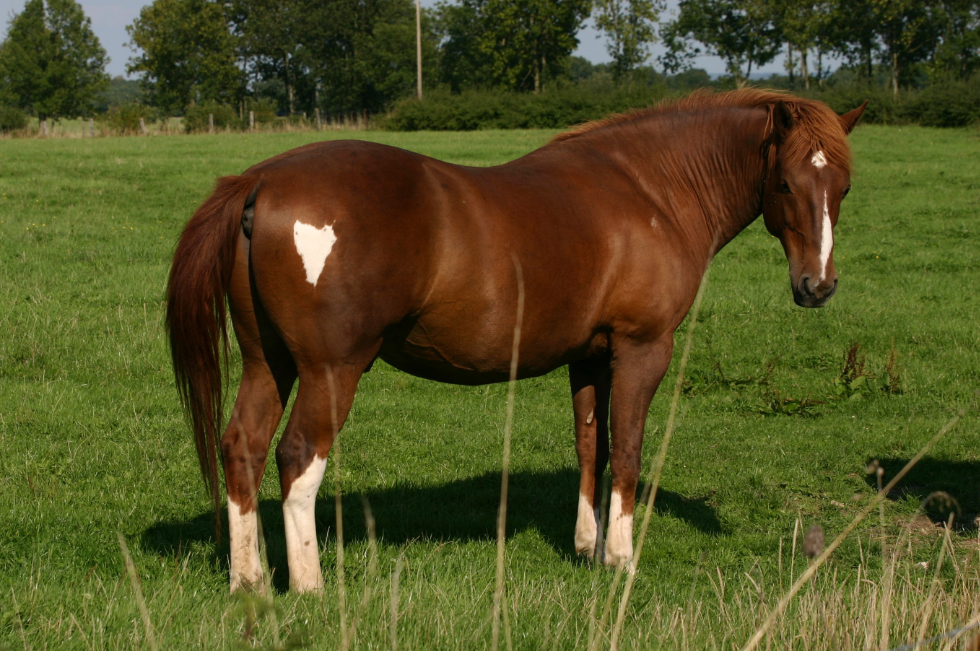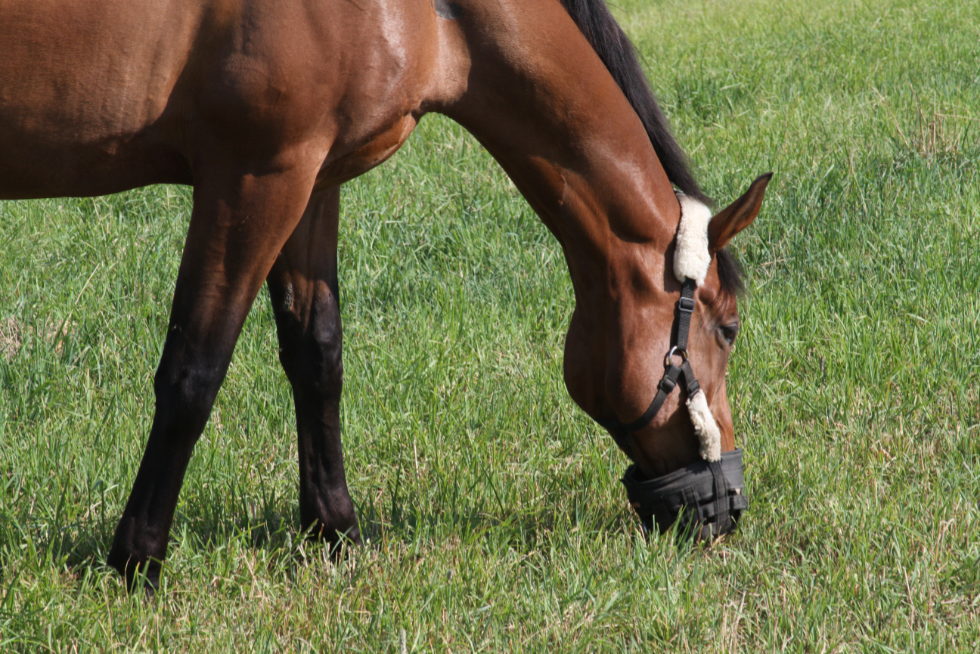Insulin Resistance
By Dr. Lydia F. Gray, posted October 2022
What is EMS and IR in horses?
Equine Metabolic Syndrome (EMS) is a condition in horses having to do with 1) insulin malfunction, 2) the presence of fat pads, and 3) a reduced ability to lose weight. These three risk factors make horses and ponies more prone to laminitis.
There are two types of insulin malfunction. One is insulin resistance (IR) and the other is hyperinsulinemia (HI). Insulin resistance is a failure of the body to respond properly to insulin. Hyperinsulinemia means high levels of insulin in the blood. Insulin is a hormone released from the pancreas after a meal, depending on how much sugar was eaten. Insulin helps digested sugar circulating in the blood (glucose) get inside cells so it can be used for energy or stored for later.

The second EMS risk factor is the presence of fat pads also called “regional adiposity.” These pockets of fat are commonly seen in the crest of the neck, at the tailhead and across the rump, behind the shoulder, above the eyes and in the sheath or mammary gland.
Owners of EMS horses commonly report their horses have a reduced ability to lose weight, the third risk factor for laminitis. They describe their horses as gaining weight on air often leading to the nickname “air ferns.” While it is most common for EMS horses to be overweight or obese, they don’t have to be. Veterinarians and nutritionists measure the amount of fat cover on a horse with the Body Condition Scoring (BCS) Scale, which ranges from 1 (extremely thin) to 9 (extremely fat). Overweight horses are in the 6 to 7 range and obese horses are in the 8 to 9 range. Ideal is considered a 5.
What causes EMS and IR in horses?
There is no one, single cause for Equine Metabolic Syndrome. Instead, the combination of genetics and environment (diet and exercise) are what puts a horse or pony at higher risk for laminitis. Certain breeds are known to have the so-called “thrifty gene,” including:
Ponies
Spanish breeds (e.g. Andalusians)
Gaited breeds (e.g. Saddlebreds, Paso Finos)
Morgans
Minis
Warmbloods
Possibly donkeys (List courtesy of The Equine Endocrinology Group)
For these at-risk breeds, it doesn’t take much inappropriate feeding and underworking to tip them into Equine Metabolic Syndrome. They’re basically “sitting ducks” when it comes to laminitis. This doesn’t mean other breeds are spared, just that it takes more high sugar/starch grain, pasture, and hay – and more stall time – to trigger the gene.
How do I know if my horse has EMS or IR?
Unfortunately, many horses are not diagnosed with Equine Metabolic Syndrome until they already have laminitis. Early signs and symptoms all owners should be looking for (but especially in the breeds listed above) include:
Obesity
Gaining weight on very little food
Reduced ability to lose weight
Fat pads (neck, shoulder, tailhead and rump, above the eyes)
Subtle lameness
Infertility
Sheath or mammary gland swelling
Any horse with these signs should be seen by a veterinarian. During the visit, the vet will perform a physical exam and take a complete history. Depending on the situation, they may perform baseline bloodwork and take x-rays of the feet. They may also test for the separate but related condition Cushing’s Disease or PPID (Pituitary Pars Intermedia Dysfunction). These tests will help your veterinarian assess your horse’s overall health and figure out if there are already signs of laminitis.
There are two “dynamic” tests for EMS. A dynamic test is when the veterinarian gives the horse a substance and then draws blood after a period time to measure the horse’s response to it. One is the Oral Sugar Test (OST) and the other is the Insulin Tolerance Test (ITT). The result of either of these dynamic tests helps the vet diagnose insulin resistance and/or hyperinsulinemia, confirming that the horse has Equine Metabolic Syndrome. If there are concerns about administering the dynamic tests, your veterinarian can draw a blood sample to look at baseline insulin levels. Ideally, owners and vets work together to determine the best method of diagnosing EMS in each individual horse.
How do I control EMS and IR in my horse?

Equine Metabolic Syndrome cannot be “cured,” but it can be managed with a low sugar/starch diet and exercise. The veterinarian will put obese horses on a very restrictive diet until they lose weight and are less of a laminitis risk. This means no grazing, no grain, and only 1.5% of their current body weight in low sugar/starch hay (i.e. less than 10-12% NSC or Non-Structural Carbohydrates). Once the horse has lost weight, the diet can be less restrictive (for example, grazing with a muzzle). If the horse does not lose weight, the vet may prescribe medication. During this weight loss period, it is very important for owners to stay in close contact with their veterinarian so the horse loses weight at a safe, controlled rate.
Ideally, the hay is analyzed for sugar/starch content. Since that’s not always possible, experts recommend soaking hay in cold water for 60 minutes to reduce the NSC level. Hay soaking has also been shown to reduce calories and promote weight loss1. Feeding a low sugar/starch ration balancer or multi-vitamin/mineral helps make sure the horse still gets his daily nutrients.
Studies show exercise improves insulin resistance and promotes weight loss in horses. However, horses with active laminitis or still recovering should not be worked until they are sound and the veterinarian gives the okay. The vet will also recommend the best exercise program for the individual horse depending on their soundness, fitness, and other factors. The important thing is to start gradually -- a few minutes at a walk – and slowly build up to trotting and cantering for longer and longer time.

Equine Metabolic Syndrome is a manageable condition in horses that doesn’t have to end in laminitis. An honest evaluation of the horse’s body condition score, attention to diet, and proper exercise can help prevent this potentially career-ending condition.
1 Considerations for the use of restricted, soaked grass hay diets to promote weight loss in the management of equine metabolic syndrome and obesity. Argo CM, Dugdale AHA, McGowan CM. Vet J. 2015 Nov;206(2):170-177.
